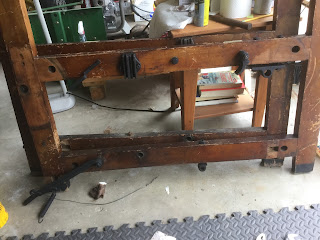I recently finished three dish towels on Julie, my Swedish counterbalance loom. The design was a six shaft, combination of plain weave and 3/1 twill stripes. I liked how they turned out, the weaving went quickly, and it was a single shuttle weave for the most part. I decided to wind another warp in different colors and rather than thread the six shafts all over again, to tie them to the old warp.
I wound each stripe of 30 or 40 threads separately, tying the cross on each bout, and placing a tight choke tie about 12" - 18" from the cross. I threaded them onto lease sticks at the front of the loom.
I left the previous towels on the loom and attached my tarp clamp temple to the edges to support them when I started to snip threads. I clipped and tied one thread at a time and tied with an overhand knot.
I don't think I saved any time, but it was easier on my eyes, neck and shoulders than threading six shafts of texsolv heddles. Everything was right in front of me. The knots slipped through the reed and heddle eyes with only a little gentle coaxing.
These are the two towels after taking them off the loom and wet finishing them. I wove them each with a different color red.
I used the lashing on method after winding on my second warp. I am becoming a fan of this method, which I learned from Milissa Ellison Dewey in one of her Facebook weaving group posts. It is fast, easy, and gives a nice even tension to the warp. I wish I had a link to post here, but can't find anything.
Below the dark blue line is the finish of the first towel in these colors. It was woven in a light gray.
I like the look of cross stripes, but can add a fair amount of extra time to my weaving and usually requiring a second shuttle.
I am not a proponent of calling errors a "design element", but I did make an error that I decided I could incorporate into the design. I intended on using a double white line evenly spaced, but accidently did a triple line, so I changed my design to alternate two and three. It isn't an error any longer!
I decided on a two pick white stripe because it is easier to overlap the ends and creates no build-up on the edges.
I measured a few pieces a bit longer that twice the width and unplied one end on each of them. The bundle is lying across the towel.
I use a stick shuttle to push the weft piece through, so both ends hang out from the edges, and then beat.
Changing to the next shed, I push both ends in until they overlap. One end is already unplied. I check for a good overlap length, allowing for my angle, and trim to the correct length and then unply the other end and overlap in the shed and beat. Once I determine the proper length of the piece of weft, I cut the remainder of them and unply the ends ahead of time.
The overlap is hardly visible. (Click on the photo to make it bigger.)
This is a great technique for weaving rag rugs if the plan is for only two passes and it saves on trying to tuck the ends in at each edge.
I use the same method when doing a single pass of rag when doing rugs, but cut the strip half the thickness and a little more than twice the width of the rug. I wrap the rag around the outer selvedge threads and overlap in the same shed, somewhere away from the edges.
I'm really liking the look of this towel, and think my goof was a good one.


















































